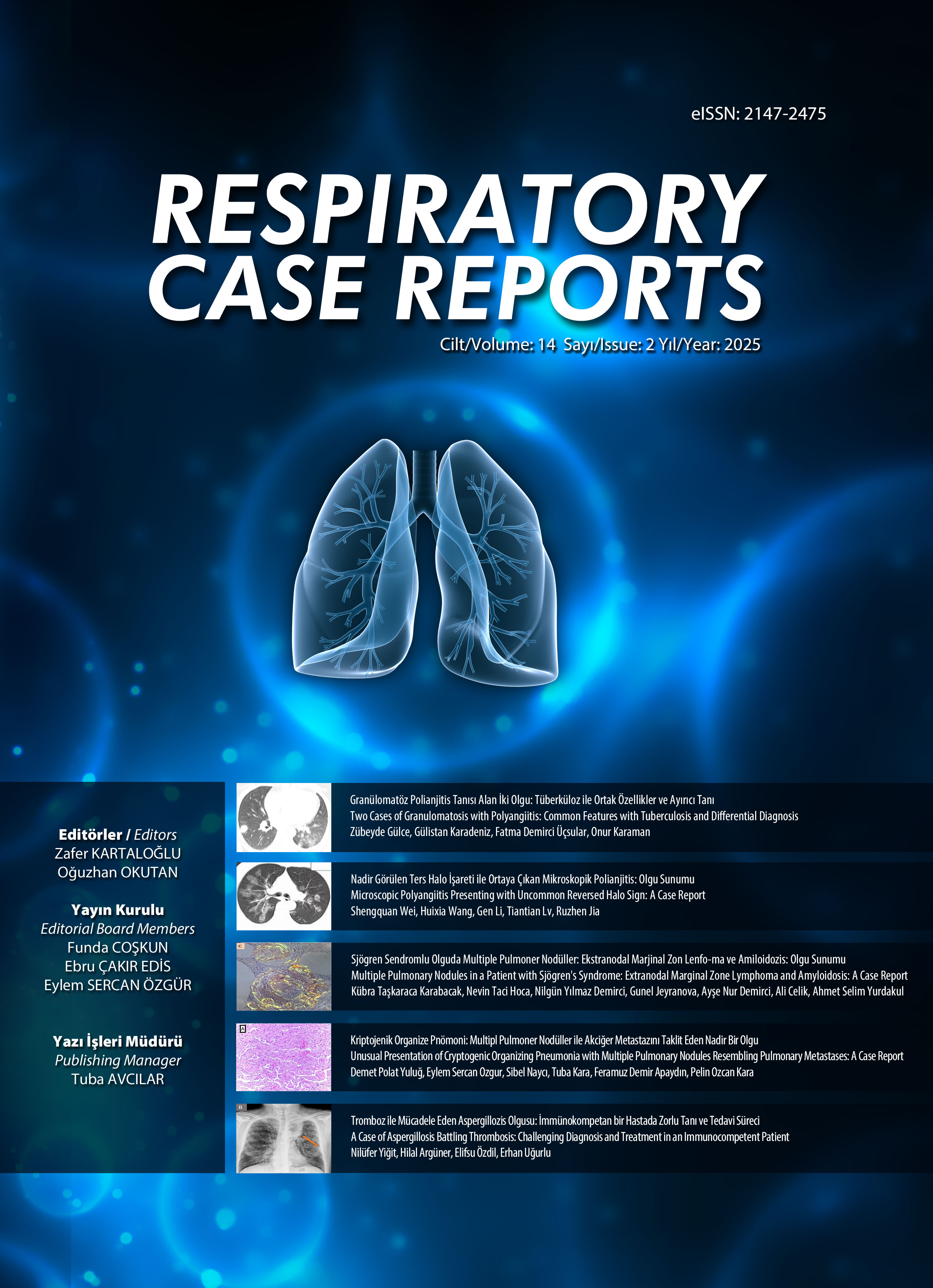e-ISSN 2147-2475

Volume: 7 Issue: 3 - October 2018
| CASE REPORT | |
| 1. | Changing Pulmonary Infiltrates in ABPA Misdiagnosed as Recurrent Pneumonia: A Case Report and Review of the Literature Shital PATIL, Gajanan Gondhali doi: 10.5505/respircase.2018.20082 Pages 134 - 139 Pneumonia is the most common respiratory problem in tropical countries like India. Allergic bronchopulmonary aspergillosis (ABPA) is routinely underdiagnosed and under evaluated as a result of clinical and radiological overlap with many other respiratory conditions, including pneumonia and tuberculosis. ABPA is the best-recognized manifestation of the fungus Aspergillus, associated with hypersensitivity to Aspergillus antigens in patients with longstanding atopic asthma. ABPA has been reported to occur in 20% of asthmatic patients admitted to hospitals and in 5% of all rhinitis cases, with varied clinical presentations. This report is a description of the case of a middle-aged male with known asthma for several years and constitutional symptoms, such as a cough, fever, and shortness of breath, who was diagnosed and treated for recurrent pneumonia. The case was eventually confirmed as ABPA, and a complete clinical and radiological response to medical treatment with antifungals and systemic corticosteroids was documented. |
| 2. | Persistent Tracheo-cutaneous Fistula: A Case Report Rajalakshmi Rajagopalan, Rabeeh Parambil, Krithika Sappavoo, Bharat Shenbagaraj, Siva Ashish, Subramaniam Suriyan, Nagesh Nalini Jayanthi doi: 10.5505/respircase.2018.50470 Pages 140 - 144 Persistent tracheo-cutaneous fistula, or persistent tracheal stoma, is a potential late complication of a tracheostomy. It commonly occurs in children due to a failure of spontaneous closure after decannulation. In adults, however, this is relatively less common. Described is a case of a 38-year-old man who, despite undergoing early and successful decannulation, presented with a persistent tracheal stoma due to pulmonary tuberculosis. |
| 3. | A Rare Case of Diffuse Alveolar Hemorrhage Secondary to Lighter Gas Inhalation Melike Yüksel Yavuz, Ceyda Anar, İbrahim Onur Alıcı, Filiz Güldaval, Nur Yücel, Melih Büyükşirin doi: 10.5505/respircase.2018.94940 Pages 145 - 148 Diffuse alveolar hemorrhage is a life-threatening condition with a varied etiology and one which may be seen with hemoptysis, anemia, diffuse pulmonary infiltrates, or respiratory failure. Toxic gas inhalation is also among the non-immune causes of this disorder. Compressed butane gas, also referred to as lighter gas, is one example, and is a volatile substance inhaled by some individuals as a means to experience euphoria. A 21-year-old male patient, who was a clerk at the courthouse, was admitted with hemoptysis. A detailed history revealed experience breathing lighter gas for pleasure. The patient was diagnosed with diffuse alveolar hemorrhage, and it was concluded that this volatile substance played a role in the etiology of the condition. Hemoptysis was not observed after the patient discontinued lighter gas inhalation and near-total regression was observed in a thorax computed tomography image taken 2 months later. This report is presented to emphasize the importance of inquiring about substance use without regard for the socioeconomic status of the patient. |
| 4. | Pulmonary Leukaemic Infiltration in Patient with Chronic Lymphocytic Leukaemia Figen Deveci, Gamze Kırkıl, Mutlu Kuluöztürk, İlknur Çalık, Önsel Öner doi: 10.5505/respircase.2018.45712 Pages 149 - 153 A 70-year-old woman who had experienced progressive dyspnea for 1 month was admitted to the emergency department. A physical examination revealed bilateral axillary lymphadenopathy and it was determined that she had undergone chemotherapy due to chronic lymphocytic leukemia (CLL) in the previous year. A hypodense lesion was observed on a thorax computed tomography image. The result of the investigation was a determination of pulmonary involvement (lymphocytic infiltration) of CLL. The case is presented in the context of a literature discussion due to the low incidence. |
| 5. | Paclitaxel Associated Lung Toxicity in a Patient with Invasive Urothelial Carcinoma Merve Erçelik, Özlem Ataoğlu, Pınar Yıldız Gülhan, Fuat Aytekin, Mehmet Fatih Elverişli, Onur Eşbah, Ege Güleç Balbay doi: 10.5505/respircase.2018.15013 Pages 154 - 157 Paclitaxel is an anti-cancer drug that induces mitotic arrest via microtubule hyperstabilization, but which also causes side effects due to its hydrophobicity and cellular promiscuity. A 71-year-old male patient presented at the polyclinic with dyspnea present for 2 weeks. In November 2016, the patient had been diagnosed with bladder-derived invasive urothelial bladder carcinoma and received 2 cycles of paclitaxel therapy. High-resolution computed tomography revealed peripheral-subpleural interlobular septal thickening, reticular densities, ground-glass density areas, and peripheral focal consolidation in both lungs, particularly on the right. Peripheral traction bronchiectasis was also observed, especially in the posterobasal segments of both lower lobes. Bronchial lavage revealed hyperplastic reserve cells, macrophages, bacterial clusters, and polymorphonuclear leukocytes, but no atypical cell were observed. The infection was ruled out. Chemotherapy was terminated and methylprednisolone (0.75 mg/kg) was initiated. Regression was observed in a control posteroanterior chest graphy after 1 month of steroid therapy. This case was presented because lung toxicity due to paclitaxel is rare. |
| 6. | Sulfasalazine Induced Eosinophilic Pneumonia Selma Aydoğan Eroğlu, Hakan Günen, Halil İbrahim Yakar, Dildar Duman doi: 10.5505/respircase.2018.93764 Pages 158 - 161 Eosinophilic lung disease encompasses a large group of diseases caused by increased blood or tissue eosinophilia. Eosinophilic pneumonia due to prescription drug use is a condition in which pulmonary infiltrates with blood or tissue eosinophilia are seen. A 28-year-old female patient admitted to the outpatient clinic with complaints of fever, chills, and a cough of 3 weeks duration. She had been taking antibiotics for 15 days with a diagnosis of pneumonia, but her complaints did not change. Her history revealed the use of sulfasalazine due to sacroiliitis. A rheumatology examination detected no other rheumatic disease. A posteroanterior chest X-ray showed bilateral peripheral opacities. A peripheral blood count revealed leukocytosis and eosinophilia. A thoracic computed tomography image revealed bilateral peripheral ground glass opacities, septal thickening, and reticular densities. Based on the findings of eosinophilia, no response to antibiotics, and no other systemic disease, it was considered that the condition might be related to the use of sulfasalazine. Sulfasalazine was discontinued and prednisolone therapy was started. The patient's symptoms improved dramatically, and the abnormal blood values returned to normal. Radiologically, complete regression was observed. This was a case of eosinophilic pneumonia due to the use of sulfasalazine. It is important that drug history is handled carefully in every pulmonary evaluation. |
| 7. | Sertraline Related Pulmonary Disease Fatih Uzer, Aliye Candan Öğüş doi: 10.5505/respircase.2018.49344 Pages 162 - 165 It has been reported that 2.5% to 3% of interstitial lung diseases are related to prescription drugs. Drugs can demonstrate side effects in all components of the respiratory system. A 68-year-old woman was admitted to the department of respiratory diseases with a history of a cough and fever present for 2 weeks. A physical examination revealed crackles in the bilateral lower zones of the respiratory system. She had a history of using sertraline for depression. Based on the results of the clinical evaluation, radiological imaging, and laboratory findings, the patient was diagnosed with interstitial pulmonary disease emerging as a side effect of prescription drug use. As drug-related interstitial lung disease is rare, this case is presented as a contribution to the literature. |
| 8. | Factor VII Deficiency as a Rare Cause of Pulmonary Thromboembolism Fatih Uzer, Tülay Özdemir doi: 10.5505/respircase.2018.30085 Pages 166 - 168 Hereditary factor VII deficiency is rare recessive autosomal disorder. It may be asymptomatic and typically presents with signs of bleeding diathesis, such as mucosal bleeding, joint and muscle hemorrhage, or intracranial hemorrhage; arterial and venous thrombosis is rare in the literature. Presently described is a case of a patient who had hereditary factor VII deficiency diagnosed with pulmonary thromboembolism. |
| 9. | Congenital Lobar Emphysema: Report of Two Cases Fatih Meteroğlu, Atalay Şahin, Menduh Oruç doi: 10.5505/respircase.2018.33154 Pages 169 - 172 Congenital lobar emphysema is a cause of respiratory distress characterized by hyperexpansion of 1 or more lobes of the lung, compression onto the ipsilateral or contralateral functional pulmonary parenchymas, and a resultant mediastinal shift. The onset of symptoms may be delayed until the age of 6 months, although the disease causes dyspnea in newborns or infancy. It is a rarely seen disease. Awareness is important due to confusion with pneumothorax and the possibility of considerable clinical improvement with early surgical intervention, even in severe cases. Two male patients with failed conservative treatment, 4 and 27 months of age, were hospitalized in this clinic because of respiratory distress and repeated infections. A left upper lobectomy was performed due to lobar emphysema in both patients. The goal of this report was to present the improvement in respiratory function and general condition of 2 patients observed after surgical management. |
| LETTER TO EDITOR | |
| 10. | Rosai-Dorfman Disease with Involvement of the Lungs Esra Karakuş, Ayşe Selcen Oğuz Erdoğan, Derya Özyörük, Gülşah Bayram doi: 10.5505/respircase.2018.26879 Pages 173 - 174 Abstract | |
| AUTHOR INDEX | |
| 11. | Author Index Pages 175 - 176 Abstract | |
| REVIEWER INDEX | |
| 12. | Reviewer Index Page 177 Abstract | |











